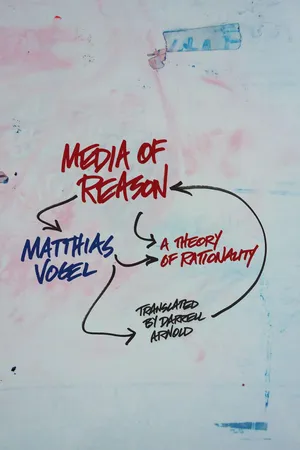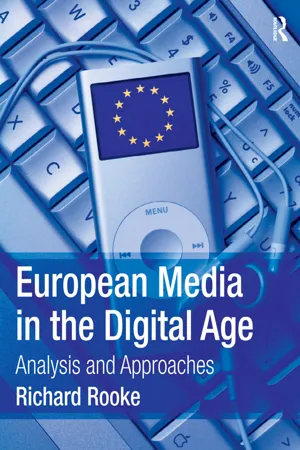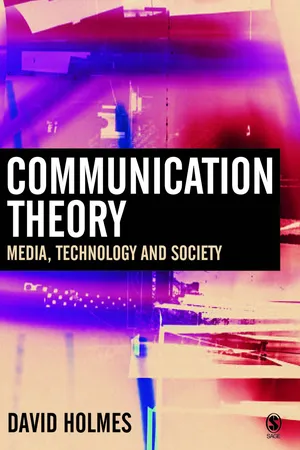Social Sciences
Media Theories
Media theories are frameworks used to understand the role and impact of media in society. They encompass various perspectives, such as the effects of media on individuals and society, the relationship between media and power, and the ways in which media shapes public opinion and culture. These theories help analyze and interpret the complex interactions between media, technology, and society.
Written by Perlego with AI-assistance
Related key terms
6 Key excerpts on "Media Theories"
- eBook - ePub
Media of Reason
A Theory of Rationality
- Matthias Vogel, Darrell Arnold(Authors)
- 2012(Publication Date)
- Columbia University Press(Publisher)
WHAT ARE MEDIA?Hardly any concept has been circulated with such numerous and often dramatically underspecified meanings as that of media. While academic reference works1 have been rather hesitant to list the concept and have only recently begun to do so—with a largely semiotic understanding—in everyday language, as well as theoretical contexts, it is used in varied ways. In social theory contexts alone the collection of explications characterizing media yields an astoundingly heterogeneous composite. On the basis of his study of the concepts of the media theory of Parsons, Luhmann, and Habermas, Jan Künzler has compiled the following list:Languages, symbolic meaning, the definition of a situation, affect, intelligence, performance capacity, value-commitment, influence, power, money, law, truth, love, joy, art, belief, reputation, the formation of transcendental order, health, the formation of empirical order: all that is supposed to be media.2If one extends the study beyond the parameters of sociology and social theory, the compilation can be extended beyond nearly all limits. So in the area of so-called media studies, a discipline that has been struggling to specify its field of research since its emergence at the beginning of the 1960s and that has been searching for a conception of medium,3 heterogeneous concepts of media have arisen, above all as a result of diverse attempts to link up with the varied vocabularies of established disciplines. Such concepts show clear traces of the theoretical contexts to which they are closely related. One can clearly differentiate between the conceptual views from public relations, information theory, and communication sociology, but also literature and theater studies.4 Alongside, and at times transverse to, these media concepts, which are closely connected with the need to provide media studies with an orientation, there is also research that refers to individual “media” such as radio or film.5 It seems to me that this situation of media studies is characterized by two features: on the one hand, by discussions that—in light of the low degree of institutionalization of the young discipline, as well as the lack of specification of the discipline that may be responsible for this—threaten to prevent developments in a discipline that merely engages in confident reassertions of its ambiguous conceptualization; on the other hand, by a marked lack of sovereignty in dealing with media concepts that are not part of media theory in the narrow sense.6 - eBook - ePub
- Denis McQuail, Mark Deuze(Authors)
- 2020(Publication Date)
- SAGE Publications Ltd(Publisher)
4 Theories of Media and Society- Media, Society and Culture: Connections and Conflicts 105
- Mass Communication as a Society-wide Process: The Mediation of Social Relations and Experience 108
- A Frame of Reference for Connecting Media with Society 112
- Theme I: Power and Inequality 114
- Theme II: Social Integration and Identity 116
- Theme III: Social Change and Development 120
- Theme IV: Space and Time 112
- Media–Society Theory I: The Mass Society 123
- Media–Society Theory II: Political Economy 125
- Media–Society Theory III: Functionalism 128
- Media–Society Theory IV: Social Constructionism 131
- Media–Society Theory V: Communication Technology Determinism 133
- Media–Society Theory VI: The Information Society 136
- Media–Society Theory VII: Mediatization 139
- Conclusion 141
In this chapter, we look more closely at ideas about the relation between (mass) media and society, reserving the cultural implications for Chapter 5 , even though society and culture are inseparable and the one cannot exist without the other. Treating society first also implies a primacy for society that is questionable, since the media can also be considered as a constitutive part of ‘culture’. In fact, most media theory relates to both ‘society’ and ‘culture’ together and has to be explained in relation to both. For present purposes, the domain of ‘society’ refers to the material base (economic and political resources and power), to social relationships (in national societies, communities, families, etc.), and to social roles and occupations that are socially regulated (formally or informally). The domain of ‘culture’ refers primarily to other essential aspects of social life, especially to symbolic expression (and the way people create shared narratives), values, meanings and practices - eBook - ePub
European Media in the Digital Age
Analysis and Approaches
- Richard Rooke(Author)
- 2013(Publication Date)
- Routledge(Publisher)
Being what it is, the media in the EU is changing at many levels: international, trans-national, private, public, regulatory models, national, regional and even local media. Change also varies according to medium – film, TV and radio, print, Internet – both convergence and divergence running in parallel. The forces on change are direct (new technology) and indirect (European regulation), internal (within states) and external (global competition).Media and communication theorySome theorists like to talk about the ‘mediating’ role of the media as an information filter. The media is the mediator (McQuail, 2005). How powerful the mediator is may be contentious, but we do know it depicts the world round us; it paints a picture for us, by word, by audio, by the visual or by the image, by old or even new technology. It touches our imagination. That is why so much time is often given in media theory to the idea of ‘meaning’: how we make sense of what is being depicted: the ‘content’ (see Point of View 5.2 ). To explore the media is to explore meaning through its dialectic and rhetoric, its grammar and depiction. To understand it is to interpret it.Point of View 5.2 DialecticsLike the media industries, philosophy and theory do not work in a social or intellectual vacuum but, it is argued, in what is often called the ‘dialectic’, a world of argument, propositions and counter propositions, thesis and antithesis, synthesis. It is also a world of rhetoric; the power, some would say the seduction, and influence of an argument. The dialectic and the rhetoric are all held together in some form of grammar; the rules of the game and how to make assertions intelligible. Drop the italicised words into any good encyclopaedia and you will see what is meant.Moreover, social and political scientists and media theorists disagree with one another on how to interpret the evidence, and that is why the debates are so interesting and intriguing (see Point of View 5.3 ).At its most glib, and like the media industries themselves, theory is prone to fashions and predominant assumptions. If these assumptions become used by those in power, it has been argued, it can change our perceptions. For example, those in charge of a nation state or any political system may encourage the media to lead us into decisions and policy-making which can radically change not only how we see the world but how we depict it. And the media if anything is a world of depiction. - eBook - ePub
Media Effects
Advances in Theory and Research
- Mary Beth Oliver, Arthur A. Raney, Jennings Bryant(Authors)
- 2019(Publication Date)
- Routledge(Publisher)
The aim of this chapter is to provide an overview of the most important media effects theories that have been coined in the past decades and to chart changes in these theories. We start by providing a definition of a media effects theory and explaining the differences between media effects theories and models. In the second section, we discuss the results of several bibliometric studies that have tried to point out the most prominent media effects theories in central communication journals, and, based on these studies we identify “evergreen” and upcoming theories. In the third section, we discuss the communalities between contemporary media effects theories along three potential characteristics of such theories: selectivity, transactionality, and conditionality. We end with a discussion of the future of media effects research, with a special focus on the necessity of the merger between media effects and computer-mediated communication theories.What Is a Media Effects Theory?
As Potter (2011) rightly observes in his review of the media effects literature, few scholars have attempted to provide a formal definition of a media effect. We can add to this observation that even fewer scholars have formulated a definition of a media effects theory. Without such a definition, it is difficult to assess which theories qualify as media effects theories and which do not. But to be able to document well-cited media effects theories that have been developed over the years, we first and foremost need a definition of a media effects theory. We define such a theory as one that attempts to explain the uses and effects of media on individuals, groups, or societies as a whole. To be labeled a media effects theory, a theory at least needs to conceptualize media use (or exposure to specific mediated messages or stories) and the potential changes that this media use can bring about in individuals, groups, or societies (i.e., the media effect). We define media use broadly as the intended or incidental use of media channels (e.g., telephone, email), devices (e.g., smartphone, game console), content/messages (e.g., games, narratives, advertising, news), or all types of platforms, tools, or apps (e.g., Facebook, Instagram, Uber). Media effects are the deliberate and non-deliberate short and long-term individual or collective changes in cognitions, emotions, attitudes, and behavior that result from media use (Valkenburg et al., 2016). - eBook - ePub
- David Hesmondhalgh, Jason Toynbee(Authors)
- 2008(Publication Date)
- Routledge(Publisher)
qua media, either because the world is considered to be a product of representation, with the media then being the central means of that representation, or else the media are treated as obscurers of the real world, as in pessimistic political economy approaches. (Of course this is a caricature, but as before we are inclined to carry on painting with a thick brush for the heuristic advantages it may bring.) In such a context, theories of causality derived from social theory enable a return to the question of media in society, itself a variant of the culture-and-society problem sketched by Raymond Williams many years ago. We can begin thinking again about how the media do things in society, how society impacts on the media, and indeed how there is complex determination through and between each. Most of all this will call for a certain despecialisation, a looking outward from the media to social relations in general. But that’s what social theory is very good at.We should, of course, concede that this outline has been one that leans towards critical realism, and away from post-structuralism; that manifests a preference for the argumentative strategies of analytical and post-analytical philosophy over Continental traditions; and that seeks synthesis rather than exploration. No doubt some of our contributors would not share such preferences. However, there are general aims of good theorising that transcend such differences, and which we believe are apparent even in the uses of theory made by chapters far removed from our own inclinations. What’s more, at a meta-level we would contend that the differences in this collection point up many of the issues we have been talking about. In other words, the book has a probing, question-raising agenda about kinds of theory and what it is for, rather than a party line. - eBook - ePub
Communication Theory
Media, Technology and Society
- David Holmes(Author)
- 2005(Publication Date)
- SAGE Publications Ltd(Publisher)
Effects analysis quickly established itself as a serious pursuit of sociological research. In American sociology, dominated as it was by positivist methodologies, the opportunity for empirical testing of the various theories about media effects presented itself (see McQuire, 1995).4 For the former function, see, for example, Leavis (1930); for the latter function, see Chakhotin (1939).5 Oddly, this latter critique is confused about the different kinds of ‘mass media’. For example, in a dictionary definition on the subject, John Hartley distinguishes between print, screen, audio and ‘broadcast’ media. Broadcast is therefore equated with whatever might be in some sense ‘live’ throughout a signal radiation apparatus (in O’Sullivan et al., 1994: 172–3). Here Hartley is caught up in a cosmology of media ‘effects’, the study of how the media affect audiences. For example, even in critiquing the idea that the media influence the mass, and arguing that audiences are much more active and intelligent than mass society theory would have us believe, the very prospect of resistance presupposes an effects model.6 The Marxist and cultural studies frameworks are primarily interested in the way media are industrially and state regulated.7
Learn about this page
Index pages curate the most relevant extracts from our library of academic textbooks. They’ve been created using an in-house natural language model (NLM), each adding context and meaning to key research topics.





